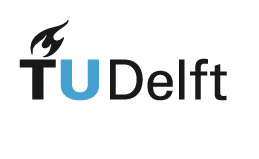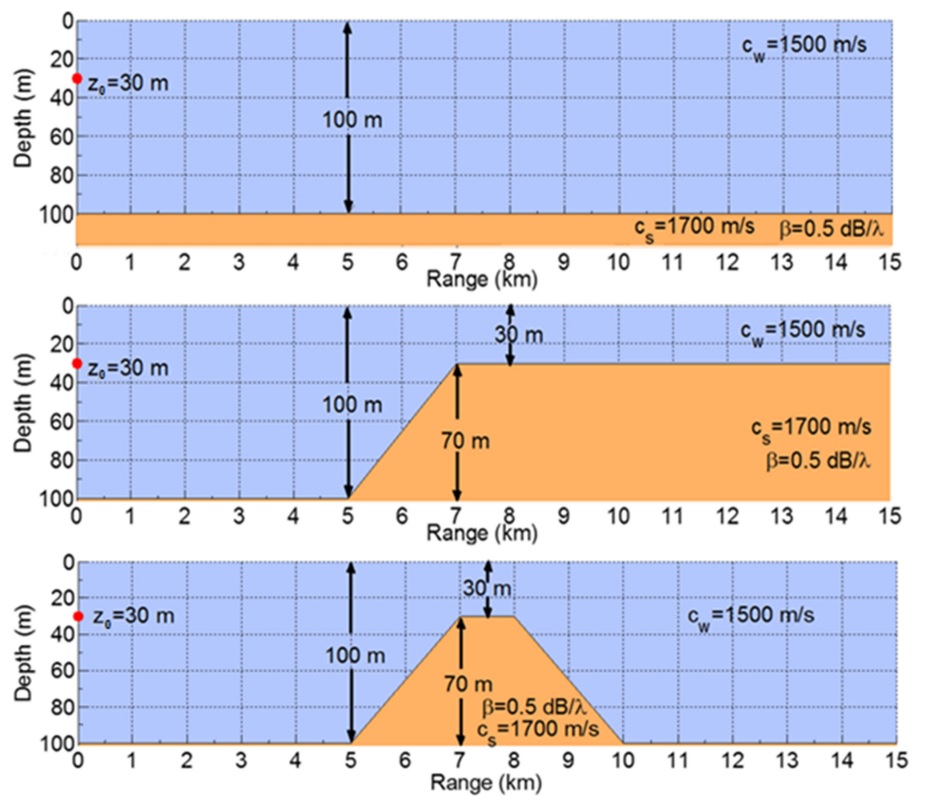Our simulations tools are sometimes used as in the underwater acoustic modelling workshops to calculate results for the workshop test scenerios. The calculated results from the following workshops will be available here soon. If you would like to share any free datasets, please contact with us.
Dataset I: Weston Memorial Workshop (WMW) 2010
The Weston Memorial Workshop (WMW) was held at the University of Cambridge in April 2010[1, 2]. Although the focus of the workshop was signal to noise ratio and signal to reverberation ratio for simple sonar problems, the test cases have been used for other sources such as ships [3,4] and seismic airguns [5,6]. The selected test cases from the WMW 2010 are used to test well-known propagation models' performance in a shallow water environment [7]. Propagation loss (PL) results are calculated with various methods (normal modes, parabolic equation, ray theory, Weston’s flux theory, hybrid mode-flux theory). For these comparisons, the acoustic propagation algorithms of KrakenC, Bellhop, Couple, Peregrine, and SOPRANO are used. Three selected test cases from the WMW 2010 are shown below [6]. The propagation loss calculations for the selected cases are available here.
The Weston Memorial Workshop (WMW) was held at the University of Cambridge in April 2010[1, 2]. Although the focus of the workshop was signal to noise ratio and signal to reverberation ratio for simple sonar problems, the test cases have been used for other sources such as ships [3,4] and seismic airguns [5,6]. The selected test cases from the WMW 2010 are used to test well-known propagation models' performance in a shallow water environment [7]. Propagation loss (PL) results are calculated with various methods (normal modes, parabolic equation, ray theory, Weston’s flux theory, hybrid mode-flux theory). For these comparisons, the acoustic propagation algorithms of KrakenC, Bellhop, Couple, Peregrine, and SOPRANO are used. Three selected test cases from the WMW 2010 are shown below [6]. The propagation loss calculations for the selected cases are available here.
Dataset II: Airgun source signatures for the International Airgun Modelling Workshop 2016
The International Airgun Modelling Workshop (IAMW) held in Dublin, Ireland, on 16 July 2016 [8,9]. For a number of specified airgun scenarios, participants in the IAMW were asked to use their models to compute source waveforms s(t) corresponding to three airgun sources, including two airgun arrays, as well as sound pressure and sound particle acceleration at specified positions relative to the sources.Three sources, denoted S1, S2 and S3 are specified by Ainslie et al. (2019). S1 is a single airgun. S2 is a line array comprising six airguns, the third of which is the same airgun as S1. S3 is a planar array comprising three nominally parallel sub-arrays, the centre sub-array of which is the same as S2. The participants of IAMW had an option to use Agora model results in their test cases. Therefore, the pre-calculated waveforms by Agora (“notional signatures” of the individual airguns for the three sources S1, S2 and S3 defined in the workshop test cases) made available here.
References
[1] M. A. Ainslie, “Editorial: Validation of sonar performance assessment tools, in validation of sonar performance assessment tools (workshop held in memory of David E. Weston, 7-9 April 2010),” Proc. Inst. Acoust., Part 2, vol. 32, pp. 1–8, 2010.
[2] M. A. Ainslie, M. Zampolli, and D. D. Ellis, “The Weston Memorial workshop: Progress to date on low frequency active sonar scenarios,” Acoust. Society Amer., vol. 17, no. 1, 2013, Art. no. 070101.
[3] M. E. G. D. Colin et al., “Definition and results of test cases for shipping sound maps,” in Proc. IEEE-MTS OCEANS Conf., Genova, Italy, May 18–21, 2015, pp. 1–19.
[4] C. Audoly et al., “Mitigation of underwater radiated noise related to shipping and its impact on marine life: A practical approach developed in the scope of AQUO Project,” IEEE J. Ocean. Eng., vol. 42, no. 2, pp. 373–387, Apr. 2017.
[5] M.A. Ainslie et al., “Verification of airgun sound field models for environmental impact assessment,” Proc. Meetings Acoust., vol. 27, no. 1, pp. 1–13, 2016.
[6] M. A. Ainslie, R. M. Laws and H. Ö. Sertlek, "International Airgun Modeling Workshop: Validation of Source Signature and Sound Propagation Models—Dublin (Ireland), July 16, 2016—Problem Description," in IEEE Journal of Oceanic Engineering, vol. 44, no. 3, pp. 565-574, July 2019, doi: 10.1109/JOE.2019.2916956.
[7] H.Ö.Sertlek, M.A. Ainslie, K. Heaney, Analytical and Numerical Propagation Loss Predictions for Gradually Range-Dependent Isospeed Waveguides , IEEE Journal of Ocean Engineering, Volume: 44 , Issue: 4 , Oct. 2019.
[8] M. A. Ainslie, R. M. Laws and H. Ö. Sertlek, "International Airgun Modeling Workshop: Validation of Source Signature and Sound Propagation Models—Dublin (Ireland), July 16, 2016—Problem Description," in IEEE Journal of Oceanic Engineering, vol. 44, no. 3, pp. 565-574, July 2019.
[9] H.O. Sertlek, M. A. Ainslie, R. M. Laws, February 10, 2019, "Agora Source Signatures for the International Airgun Modelling Workshop ", IEEE Dataport, doi: https://dx.doi.org/10.21227/5081-yr65.

